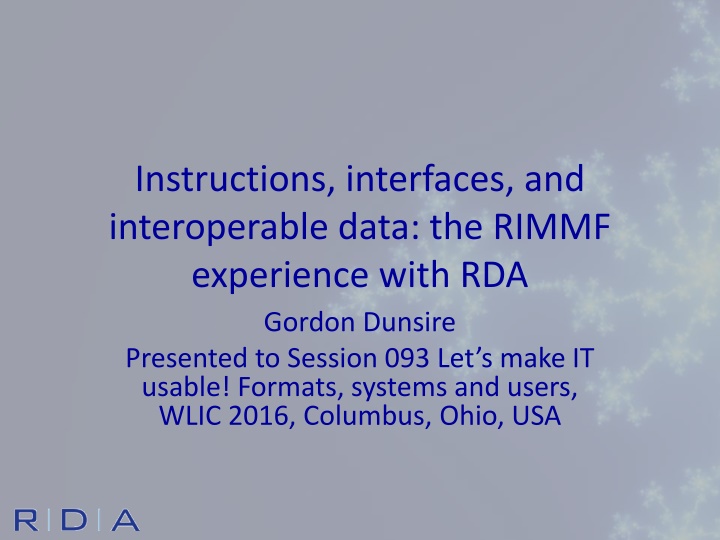
Interoperable Data and RDA: Enhancing Metadata Creation
Explore the evolution and impact of RDA on cataloguing systems and metadata creation in libraries. Learn about RIMMF, RDA Toolkit, and rich relationships in library data management, emphasizing the importance of user-focused linked data applications.
Download Presentation

Please find below an Image/Link to download the presentation.
The content on the website is provided AS IS for your information and personal use only. It may not be sold, licensed, or shared on other websites without obtaining consent from the author. If you encounter any issues during the download, it is possible that the publisher has removed the file from their server.
You are allowed to download the files provided on this website for personal or commercial use, subject to the condition that they are used lawfully. All files are the property of their respective owners.
The content on the website is provided AS IS for your information and personal use only. It may not be sold, licensed, or shared on other websites without obtaining consent from the author.
E N D
Presentation Transcript
Instructions, interfaces, and interoperable data: the RIMMF experience with RDA Gordon Dunsire Presented to Session 093 Let s make IT usable! Formats, systems and users, WLIC 2016, Columbus, Ohio, USA
Cataloguing in the 21stcentury From AACR/ISBD/MARC To FRBR/RDA/Linked data Asynchronous development Insufficient liaison, funding, priorities Cataloguing systems lag behind everything Wait until it stops changing Cataloguers working in a hybrid environment
RDA data RDA is a package of data elements, guidelines, and instructions for creating library and cultural heritage resource metadata that are well-formed according to international models for user-focussed linked data applications. RDA Toolkit provides the user-focussed elements, guidelines, and instructions. RDA Registry provides the infrastructure for well-formed, linked, RDA data applications. Open Metadata Registry (OMR) provides linked data representation of RDA elements.
Rich relationships require finer granularity AACR2 ISBD MARC Resource RDA FRBR Work Expression Linked data Manifestation Item
Technical terminology: I say this; you say that RDA/FRBR entity element element sub-type designator vocabulary encoding scheme value vocabulary term Linked data/RDF class property sub-property property concept The users say ?
RIMMF: RDA in Many Metadata Formats Developed as a training tool and prototype interface for RDA RIMMF3 uses RDA linked data
Manifestation data with RDA Registry (linked data) labels Indicates focus/domain of the element/property
RIMMF support for multilingual cataloguing Uses linked data language indicators All data is taken from RDA Registry
Legacy data: MARC21 to RDA linked data MARC21 RIMMF RDA Semantic Web RDF linked data MARC21 Legacy systems
Global fun with RDA: the jane-athons Jane-athon: A hackathon for RDA data using RIMMF ALA Midwinter 2015: topic: Jane Austen and her works Wellington (New Zealand) Edinburgh (Scotland) Madrid (Spain) Stockholm (Sweden) USA (x5) Paris (France) London (England) Riga (Latvia) The Hague (The Netherlands)
Conclusion The "harmony" of international bibliographic standards in the 20th century is unlikely to happen again And will not be necessary (Semantic Web) Cataloguers will need tools like RIMMF to provide a common (harmonious?) view of metadata from many source And so will users.
Thank you! rscchair@rdatoolkit.org RDA Steering Committee http://www.rda-rsc.org/ RDA Toolkit http://www.rdatoolkit.org/ RDA Registry http://www.rdaregistry.info/ Open Metadata Registry http://metadataregistry.org/ RIMMF http://www.marcofquality.com/wiki/rimmf3/ Jane-athons, etc. http://rballs.info/
